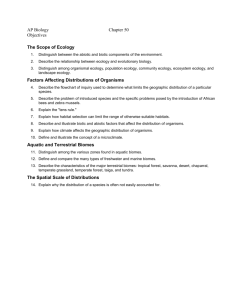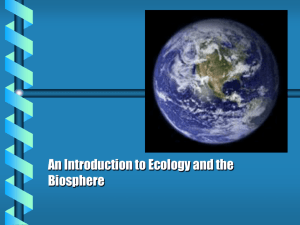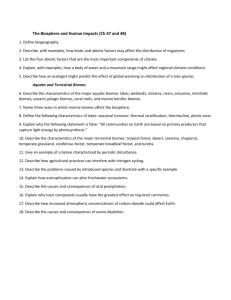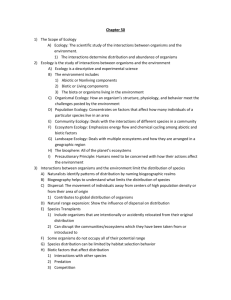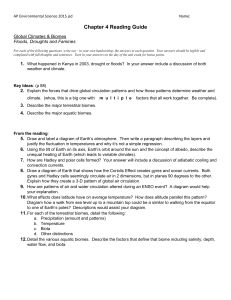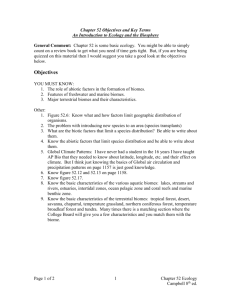Chapter 50 - Canyon ISD
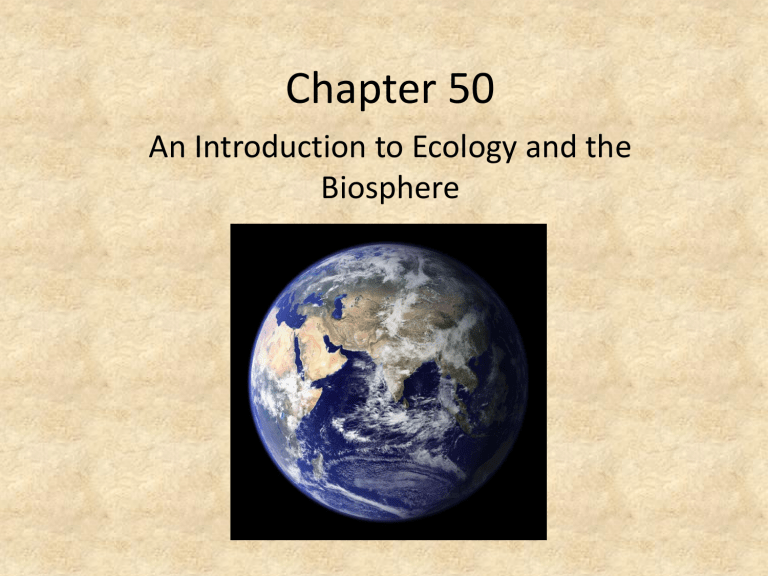
Chapter 50
An Introduction to Ecology and the
Biosphere
Scope of Ecology
• Always had an interest in ecology
– Hunters and gatherers had to learn where game and edible plants could be found in great abundance
• Historically it was only a descriptive science, but is becoming more experimental
Ecology
• Interactions between organisms and their environment
– Determine the distribution and abundance of organisms
• Ex: Distribution map of red kangaroo
• Poses a couple of ecological questions:
– What factors limit the geographic range, or
distribution, of a species?
– What factors determine their abundance?
• Can test hypotheses by two ways:
– Field study
• Hard because you have to test a “big idea” on a little manageable space
– Mathematical equations
• Only as good as the data being put into them
Components
• Abiotic components: nonliving chemical and physical factors
– Temperature, light, water, and nutrients
• Biotic components: living factors
– All the organisms that are part of any individual’s environment
Ecology and Evolutionary Biology
• Charles Darwin was a naturalist whose observations laid the groundwork for the later development of ecology
– It was the geographic distribution of organisms and their adaptations to environments that began evolution
• An important cause of evolutionary change is the interaction of organisms with their environment
– Events that occur in the framework of ecological time
(minutes, years) translate into effects in evolutionary time
Ecology and Evolutionary Biology
• An example:
– A hawk feeds on field mice and has an immediate
(ecological) impact on the prey population by killing certain individuals, thereby reducing population size and altering the gene pool
– Evolutionary effect of this predator-prey relationship may be selection for mice with fur coloration that camouflages the animals
Levels of the Biosphere
• Individual
• Population
– Group of the same species in one area
• Community
– All the organisms of all the species that inhabit an area
• Ecosystem
– Consists of all the abiotic factors in addition to the entire community of species in an area
• Landscape
– Consists of several different ecosystems linked by exchanges of energy, materials, and organisms
• Biosphere
– Global ecosystem: atmosphere to land below ground
Ecological Research
• Divided into 5 levels of study
– Organismal ecology: concerned with the morphological, physiological, and behavioral ways in which an individual meets the challenges posed by their abiotic and biotic environment
• Geographic distribution is often limited by the abiotic conditions they can tolerate
– Population ecology: concentrates mainly on factors that affect how many individuals of a particular species live in an area
Ecological Research
– Community ecology: deals with the whole array of interacting species in a community
• Focuses on the ways in which interactions such as predation, competition, and disease affect community structure and organization
– Ecosystem ecology: emphasis is on energy flow and the cycling of chemicals among the various biotic and abiotic factors
– Landscape ecology: deals with arrays of ecosystems and how they are arranged in a geographic region
• Focuses on the ways in which interactions among populations, communities, and ecosystems are affected by the juxtaposition of different ecosystems
Ecology and Environmental Issues
• Started with Silent Spring
– DDT will kill all the birds
• Acid rain, localized famine aggravated by land misuse and population growth, poisoning of soil and streams with toxic wastes, growing list of endangered and threatened species because of habitat destruction
• MUST communicate the scientific complexity of environmental issues
– Educate legislators and general public
– Precautionary principle: “look before you leap”
Factors Affecting the Distribution of
Organisms
• Biogeography: study of the past and present distribution of individual species
– Noticed they are dispersed in realms
Factors Affecting the Distribution of
Organisms
• Species dispersal affects distribution
– Species Transplants:
• Can determine if dispersal is key limiting factor by observing the results when humans transplant a species
• Transplant Successful: distribution limited because the area is inaccessible, time has been too short to reach the area, or the species fails to recognize the area as suitable living space
• Transplant Unsuccessful: distribution limited either by other species or by physical and chemical barriers
Factors Affecting the Distribution of
Organisms
• If a species is successful, then the potential range is larger than its actual range
– If a species does not occupy all of its potential range, we ask why
• Does it lack suitable means of dispersal to new areas?
• Some can move into new areas but choose not to
• If a species cannot survive and reproduce in the transplant areas, we ask if it is biotic or abiotic factors that exclude it from areas
– Limits imposed by other species
• Predators, parasites, pathogens, competitors
– Lack required positive effects of interdependent species
• Pollinators
– Physical or chemical factors set the range
• Temperature extremes
Factors Affecting the Distribution of
Organisms
• Problems with introduced species:
– African Honeybee
• Brought to Brazil in 1956 to breed a variety that will produce more honey
• Escaped in 1957
• Drive out established colonies of honeybees
• Aggressive towards humans and domestic animals and have caused several deaths
– 10 in 2000 in US
Factors Affecting the Distribution of
Organisms
– Zebra Mussel
• 1998: discovered in Lake St. Claire by Detroit
• Introduced from ballast water
• Reproduces quickly and forms dense clusters several layers thick on hard surfaces
• First noticed when they reached density of 750,000/sq. meter and clogged up the water intakes of city water systems, electrical power stations, and industrial facilities in Great Lakes
• Resulted in local extinctions of native freshwater clams
Factors Affecting the Distribution of
Organisms
– Tens Rule:
• Statistical prediction that an average of one out of ten introduced species become established
– One out of ten established species becomes pests
• What species around here are introduced pests?
Factors Affecting Distribution of
Organisms
• Behavior and Habitat Selection
– Plants and animal species select habitat
– Evolution does not produce perfect organisms for every suitable habitat
• Biotic Factors
– A species cannot complete its full life cycle if transplanted to a new area
• Negative interactions with other organisms through predation, disease, and competition
• Absence of species that they depend on
Factors Affecting Distribution of
Organisms
– Predation
• Inverse relationship between abundance of sea urchins and abundance of seaweeds
• Sea urchins graze on kelp
– Local distribution of kelp is limited by sea urchins
– Can be tested by “removal and addition” experiments
» If urchins are removed, kelp will become more abundant
– Introduction of exotic predators and disease
Factors Affecting Distribution of
Organisms
• Abiotic Factors
– Temperature:
• Effects biological processes and the inability of most organisms to regulate body temperature precisely
• Cells rupture if too cold, proteins denature if too hot
– Water:
• Availability varies dramatically among habitats
• Water balance problem in aquatic species
• Desiccation problems with terrestrial species
Factors Affecting Distribution of
Organisms
– Sunlight:
• Shading by a forest canopy makes competition for light in the understory intense
• Intensity and quality of light in aquatic environments
• Development and behavior of many organisms
– Photoperiods: relative lengths of daytime and nighttime
» More reliable indicator than temperature for cuing seasonal events
– Wind
• Amplifies the effect of temperature on organisms by increasing heat loss due to evaporation and convection, water loss, and changes morphology of plants
Factors Affecting Distribution of
Organisms
– Rocks and Soil
• Physical structure, pH, and mineral composition of rocks and
• Soil can affect water chemistry
Climate
• Prevailing weather conditions at a locality
• Temperature and water!
• Climate and Biomes:
– Biomes are major types of ecosystems, those that occupy broad geographic regions
• Ex: coniferous forests, deserts, grasslands
Global Climate
• Largely determined by the input of solar energy and the planet’s movement in space
• Sun’s warming effect on the atmosphere, land and water establishes the temperature variations, cycles of air movement, and evaporation of water responsible for dramatic latitudinal variation in climate
Microclimate
• Climate that varies on the small scale
– Ex: Forest Floor or under a rock
• Affected by casting shade, affecting evaporation from soil, and changing the patterns of wind
Aquatic Biomes
• Account for the largest amount of area
• Salt biomes = 3% salinity
• Freshwater = less than 1% salinity
• Covers about 75% of Earth’s surfaces
• Major impacts
– Evaporation of sea water provides most of the planet’s rainfall
– Ocean temps affect world climate and wind patterns
Aquatic Biomes
• Vertical stratification:
– Light is absorbed by both the water and the microorganisms in it
• Intensity decreases rapidly with depth
– Distinguish between the upper photic zone (where there is sufficient light for photosynthesis) and the lower aphotic
zone (little light penetrates
– Water temperature is also stratified
• Thermocline: a uniformly warm upper layer and cold deeper waters
– Benthic Zone: substrate of aquatic biomes, made of sand, and organic and inorganic sediment (ooze)
• Benthos: organisms that live in the benthic zone
• Detritus: dead organic matter that is food for the benthos
Aquatic Biomes
• Freshwater Biomes:
– Standing bodies (lakes and ponds)
– Moving bodies (rivers and streams)
– Lakes:
• Organisms are distributed according to the depth of water and its distance from shore
• Rooting and floating plants live in the littoral zone
– Shallow, well-lit waters close to shore
• Well lit, open surface waters farther from shore are the limnetic zone
• Profundal zone is the aphotic regions and down to the benthic zone
Aquatic Biomes
• Often classified according to their production of organic matter
– Oligotrophic lakes are deep and nutrient-poor, and the phytoplankton in the limnetic zone are relatively sparse and not very productive
– Eutrophic lakes are shallow, with a high nutrient content, very productive and numerous phytoplankton
» Waters are often murky
– Mesotrophic lakes: intermediate between the two
– May change from one variety to another, and humans speed up the process from runoff and dumping
Aquatic Biomes
• Streams and Rivers
– Very little sediment at head of rivers, very little nutrients as well
– More accumulates down the way
– Nutrient content is largely determined by the terrain and vegetation the water flows through
• Fallen leaves, weathering rocks, turbulent flow
Aquatic Biomes
• Wetlands:
– Area covered in water that supports aquatic plants
• Range from periodically flooded regions to soil that is permanently saturated during the growing season
• Favor the growth of specially adapted plants called
hydrophyes which can grow in water or in soil
– Include pond lilies, emergent cattails, and black spruce
– Hydrology and vegetation of an area are important determinants of its classification as a wetland
• Can be critical when federal, state, and local governments are making preservation decisions
Aquatic Biomes
– Range from marshes to swamps to bogs
• Generally develop in one of three topographical situations
1. Basin wetlands: develop in shallow basins, ranging from upland depressions to filled-in lakes and ponds
2. Riverine wetlands: develop along shallow and periodically flooded banks of rivers and streams
3. Fringe wetlands: occur along coasts of large lakes and seas where water flows back and forth because of rising levels or tides
– Among the riches of biomes, with a variety of species, ecological and economic value
Aquatic Biomes
• Estuaries:
– Area where freshwater streams or rivers diverge with the ocean
– Often bordered by extensive coastal wetlands called mudflats and salt marshes
– Salinity varies spatially, and temporally
– Nutrients make this very productive biome
– Many animals breed, live, or pass through estuaries
Aquatic Biomes
• Zonation in Marine Communities:
– Communities are distributed according to the depth of the water, degree of light penetration, distance from shore, and open water versus bottom
– Intertidal zone: where land meets water
– Neritic zone: shallow regions over the continental shelf
– Oceanic zone: past the continental shelf
– Pelagic Zone: open water
– Benthic zone: sea floor
Aquatic Biomes
• Intertidal Zones
– Communities are subject to huge daily variations in the availability of seawater and in temperature
– Rocky intertidal zone
• Most organisms have structural adaptations that enable them to attach to the hard substrate
– Sandy intertidal zone
• Many are suspension feeders, predators, or scavengers
Aquatic Biomes
• Coral Reefs
– Currents and waves constantly renew nutrient supplies to the reef, and sunlight penetrates to the ocean floor
– Global warming is causing “bleaching’, where the dinoflagellate algae leave the coral, reducing their photosynthetic rate
Aquatic Biomes
• Oceanic Pelagic Biome
– Constantly mixed by ocean currents
– Nutrient concentrations are generally lower in the open ocean than the coastal areas
• Benthos
– Nutrients arrive by “raining down” in the form of detritus
– Abyssal zone: very deep, constantly cold, high pressure, no light, low nutrients
Terrestrial Biomes
• Often named for major physical or climatic features, and for their predominant vegetation
• Forest stratification:
– Canopy, low-tree stratum, shrub understory, ground layer of plants, forest floor, root layer
• Ectotone: are of intergradations between biomes
Terrestrial Biomes
• Dynamic, and natural disasters rather than stability tends to be the rule
• Biomes exhibit extensive patchiness, with several communities represented in one area
– Hurricanes open up tropical and temperate forests
– Old trees die and fall and allow different species to come in
– Fire is an integral component of grasslands
Terrestrial Biomes
• Tropical Forest:
– Pronounced vertical stratification
– Canopy is often closed, so that little light reaches the ground
• Trees and vines compete for light
• Many of these trees are covered in epiphytes which are plants that grow on other plants instead of in soil
– Orchids
Terrestrial Biomes
• Savanna
– Grasses and scattered trees
– Fire is an important abiotic factor
Terrestrial Biomes
• Desert:
– Less than 30 cm rain a year
– Organisms are adapted to store water
Terrestrial Biomes
• Chaparral
– Dense, spiny, evergreen shrubs dominate
– Mild, rainy winters with long, hot, dry summers
– Plants are adapted and dependent on periodic fires
Terrestrial Biomes
• Temperate Grassland
– Season drought, occasional fires, grazing by large mammals
• Prevent establishment of woody shrubs and trees
– Soil is deep and rich in nutrients
• Most in US have been converted to farmland
Terrestrial Biomes
• Temperate Deciduous forest
– Drop their leaves before winter when temperatures are too low for effective photosynthesis
– Houses a lot of hibernating animals
Terrestrial Biomes
• Coniferous Forest
– Cone-bearing trees
– Taiga: largest terrestrial biome on earth
• Receives heavy snowfall in winter, and conical shape of trees prevents too much accumulation that can lead to damage
Terrestrial Biomes
• Tundra
– Permafrost (permanently frozen subsoil), bitterly cold temperatures, high winds
– Absence of trees and other tall plants
– Receive very little rain fall
